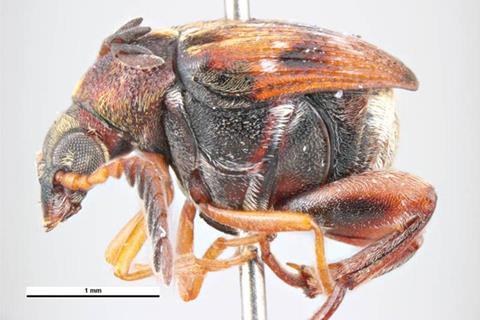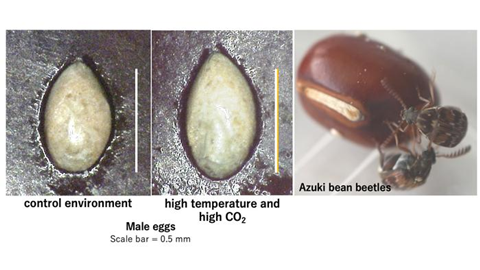Researchers at Kyushu University have found that when azuki bean beetles infected with Wolbachia bacteria are exposed to a simulated climate change environment—characterized by elevated temperature and carbon dioxide—they tend to produce larger eggs to enhance the survivability of their offspring. Interestingly, these larger eggs gave rise exclusively to male larvae.

The study, published in Scientific Reports, demonstrates the benefits of Wolbachia infection under adverse environmental conditions in these beetles. It is also the first observation of sex-dependent changes in egg size in a species with chromosomal sex determination.
READ MORE: Reproductive biology though the lens of the microbiome
READ MORE: Field deployment of Wolbachia-infected mosquitoes using uncrewed aerial vehicle
The azuki bean beetle (Callosobruchus chinensis) is a small insect, growing up to about 3 mm in length, and is a known pest of stored legume seeds. These beetles lay their eggs on the seed surface, and once hatched, the larvae bore into the seeds. Understanding their biology is therefore essential for mitigating the damage they cause.
“One characteristic we’ve observed in some insects, including these beetles, is that they increase egg size when exposed to environmental stress. Offspring hatched from larger eggs tend to survive better and develop more quickly during early stages. It’s a form of biological investment under stressful conditions” explains Professor Midori Tuda of Kyushu University’s Faculty of Agriculture, who led the study. “With human activities raising atmospheric CO₂ and global temperatures, it is critical to predict the future population dynamics of agricultural pests like the azuki bean beetle.”
Parasitic microbe
Another factor influencing egg size in insects is infection by Wolbachia, one of the most common parasitic microbes in insects. It can cause a variety of effects across species. For example, in thrips and mites—where sex is determined by haplodiploidy (i.e., whether the offspring has a full or half set of chromosomes)—Wolbachia-infected parents have been shown to produce larger eggs, but only those that yield female offspring.
“We combined these two ideas to examine whether Wolbachia infection influences egg size under elevated temperature and CO₂ conditions, and whether this affects offspring sex,” continues Tuda. “In azuki bean beetles, sex is determined by X and Y sex chromosomes, just like in humans. To our knowledge, no one has previously investigated sex-specific changes in egg size under such conditions in organisms with this type of sex determination.”
Approximately 96% of natural azuki bean beetle populations are coinfected with two strains of Wolbachia: wBruCon (referred to as Con) and wBruOri (referred to as Ori). Single infections with either strain are rare: 1.6% of the population is infected only with Con, and 2.4% only with Ori.
Climate change experiment
The researchers exposed beetles to elevated temperature and CO₂ (denoted as eT&CO₂) for over two days during egg-laying. They found that beetles coinfected with both Wolbachia strains produced larger eggs, and all the larger eggs developed into male larvae. Egg size increases were observed only in beetles coinfected with both strains of Wolbachia.
Interestingly, the adult lifespan of the offspring was influenced not by egg size, but by environmental conditions, sex, Wolbachia infection, and development time. In fact, eT&CO₂ reduced male lifespan but had no significant effect on females.

This study is the first to demonstrate sex-specific egg size changes due to Wolbachia infection in a species with chromosomal sex determination. Further research is needed to elucidate the mechanisms driving this sex-dependent change aided by Wolbachia coinfection.
“From a pest control perspective, targeting Wolbachia may be a strategy worth exploring. However, because nearly half of all insect species are infected with Wolbachia, non-selective use of bactericides could threaten non-pest insects as well,” concludes Tuda. “A nature-positive approach is essential as we adapt to a changing climate.”







No comments yet